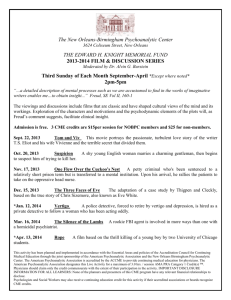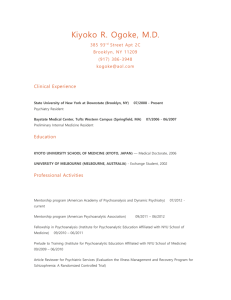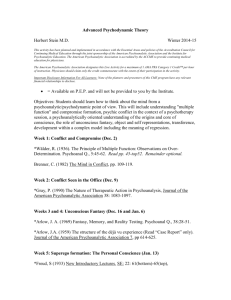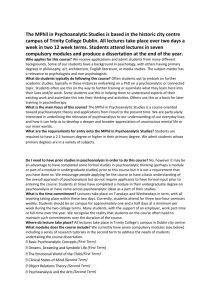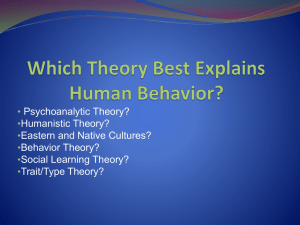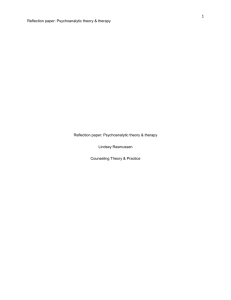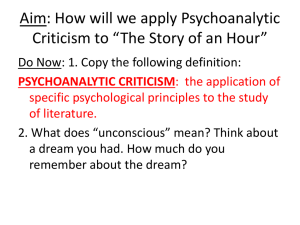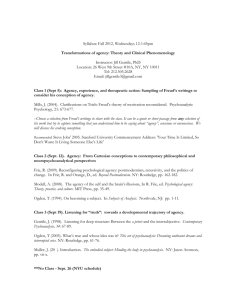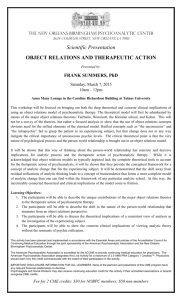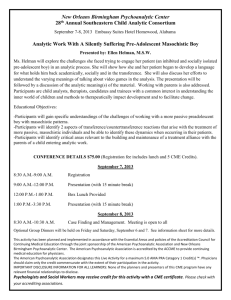The formation and deformation of identity during
advertisement
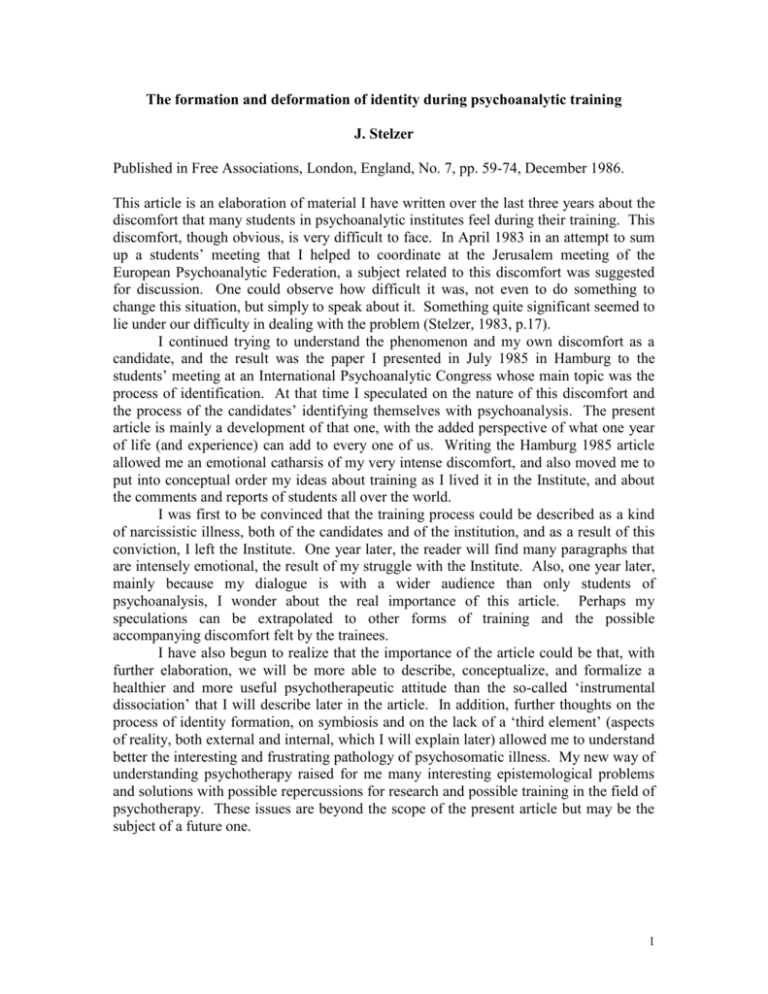
The formation and deformation of identity during psychoanalytic training J. Stelzer Published in Free Associations, London, England, No. 7, pp. 59-74, December 1986. This article is an elaboration of material I have written over the last three years about the discomfort that many students in psychoanalytic institutes feel during their training. This discomfort, though obvious, is very difficult to face. In April 1983 in an attempt to sum up a students’ meeting that I helped to coordinate at the Jerusalem meeting of the European Psychoanalytic Federation, a subject related to this discomfort was suggested for discussion. One could observe how difficult it was, not even to do something to change this situation, but simply to speak about it. Something quite significant seemed to lie under our difficulty in dealing with the problem (Stelzer, 1983, p.17). I continued trying to understand the phenomenon and my own discomfort as a candidate, and the result was the paper I presented in July 1985 in Hamburg to the students’ meeting at an International Psychoanalytic Congress whose main topic was the process of identification. At that time I speculated on the nature of this discomfort and the process of the candidates’ identifying themselves with psychoanalysis. The present article is mainly a development of that one, with the added perspective of what one year of life (and experience) can add to every one of us. Writing the Hamburg 1985 article allowed me an emotional catharsis of my very intense discomfort, and also moved me to put into conceptual order my ideas about training as I lived it in the Institute, and about the comments and reports of students all over the world. I was first to be convinced that the training process could be described as a kind of narcissistic illness, both of the candidates and of the institution, and as a result of this conviction, I left the Institute. One year later, the reader will find many paragraphs that are intensely emotional, the result of my struggle with the Institute. Also, one year later, mainly because my dialogue is with a wider audience than only students of psychoanalysis, I wonder about the real importance of this article. Perhaps my speculations can be extrapolated to other forms of training and the possible accompanying discomfort felt by the trainees. I have also begun to realize that the importance of the article could be that, with further elaboration, we will be more able to describe, conceptualize, and formalize a healthier and more useful psychotherapeutic attitude than the so-called ‘instrumental dissociation’ that I will describe later in the article. In addition, further thoughts on the process of identity formation, on symbiosis and on the lack of a ‘third element’ (aspects of reality, both external and internal, which I will explain later) allowed me to understand better the interesting and frustrating pathology of psychosomatic illness. My new way of understanding psychotherapy raised for me many interesting epistemological problems and solutions with possible repercussions for research and possible training in the field of psychotherapy. These issues are beyond the scope of the present article but may be the subject of a future one. 1 THE CONCEPT OF IDENTITY AND PSYCHOANALYTIC THINKING I would like to speculate on the relationship between the discomfort felt by candidates during psychoanalytic training and the process of identifying themselves with psychoanalysis. This will require some comments on the status of the concept of identity in psychoanalysis. I won’t define this concept. And it’s worth noting that it does not appear in Laplanche and Pontalis’s psychoanalytic dictionary. Andre Green, participating in a seminar on identity led by Claude Levi-Strauss, pointed out how psychoanalytic discovery (mainly of the unconscious) was a shock to all the ideas related to the concept of identity (Green, 1981, pp.87-118). Identity is normally associated, in non-psychoanalytic terms, with permanence, constancy, no change with time; and it refers us to some idea of boundary, of being an isolated unit. Green also said that identity could be one of the possible relationships between two elements, the one that we recognize as identical. The three elements together—constancy, unity, recognition of sameness—define consciousness for the philosopher. (Is identity a synonym for consciousness of ourselves, even with its unconscious contribution?) But these three main elements of identity (to be, to be one and to be the same) are questioned by psychoanalysis. The discovery of the concept of the unconscious questions the unity of consciousness. Also, the Ego is defined only in relation to the other two elements, Id and Superego. Andre Green said: ‘The Individual is not a concept in Freud…The Ego is not the Subject,’ and finally, ‘The Subject cannot be defined in the psychoanalytic perspective except through his relationship with his parents.’ For me, this means that the Others are central in defining the individual, that by itself is split in his consciousness (by the fact that it is determined by others?). From another perspective (an attempt to define the specific conceptual field of ‘self’), Kohut wrote, ‘Personality…like identity is not indigenous to psychoanalytic psychology: it belongs to a different theoretical framework which is more in harmony with the observation of social behaviour and the description of the (pre)conscious experience of oneself in the interaction with others than with the observations of depth psychology’ (Kohut, 1971, pp.xiv-xv). Chiland expresses a similar opinion in her description of the process of identity formation in the infant. She said, as material for further speculation, that ‘because the development of the baby depends upon the care of others, it could be said that the progressive process of identification is also a process of steady alienation’, strongly agreeing that the concept of identity in the sense of personal identity is not psychoanalytic, or at least not Freudian (Chiland, 1982). Rather, identification is the concept that is compatible with psychoanalytic way of thinking. The suffix ‘tion’ emphasizes the process of interaction with an other, one of dialectic dependence with one or more others through which an individual consciously and/or unconsciously arrives at a determination of what and who he is. It is in that sense that, inevitably, psychoanalysis places itself in the stream of thought that considers that the way individuals or groups ‘see’ themselves is a function of their ‘place’ in a specific social-economic-familial structure. Possibly the unique contribution of psychoanalysis among these streams of thought is its clarification of the rules of the process of ‘how we see ourselves’, starting from the psychoanalytical clinical experience. At least this is what happened historically 2 within the field of psychoanalysis. From the clinical study in the psychoanalytic situation of different psychopathalogical structures, different elements of the process of identity formation were explicated. Different authors from their clinical psychoanalytic experience, with different clinical pictures, contributed to describing those elements of the process that appeared most easily in those different clinical conditions. So the relative part played by the building up of a body image, the circumstances of being raised in a specific family group with a specific family history, and also the psychoanalytic study of institutions, were described by different authors. The role played by our bodies (through the body image) in the concept we have of ourselves was explicated by Schilder from his studies of hysterical patients and those suffering from focal brain lesions (Shilder, 1950). He wrote, ‘In hysterical cases…the psychogenic part of our emotions connected with the postural model of the body provokes phenomena very similar to organic repression.’ And he also was one of the pioneers in exploring the dialectic of identification: ‘ego’ and ‘thou’ are not possible without the other, and ‘ego’ and ‘thou’, personality, body, world are separate entities; but then there occurs the continual psychological process which changes the relation between the body images of various persons. From the treatment of psychotic, psychosomatic, anorexic conditions, as well as children and adolescents in general, we have come to recognize the ways in which the structure of the social system in which they develop— that is, the family—influences the formation and deformation of our patients’ sense of identity (Stelzer, 1984, p.291). We will try to do the same with the problem of the discomfort of the candidate during psychoanalytic training, firstly to describe the ‘clinical features’ of the discomfort, its symptomatology during different stages of training, and secondly to correlate symptomatology with the structure in which the candidate is placed in the general field of psychoanalytic hierarchy. (We use the concept of structure, not in the sense of the Freudian second topological model, but as a whole that is more than the sum of its parts.) THE PHENOMENOLOGY OF THE DISCOMFORT During the first stage of training, the predominant feeling of candidates is one of marked vulnerability, of loss of self-esteem. Feelings of uncertainty are added at each stage about whether or not they will be promoted (that is, accepted) for the next stage: first to be accepted as a student at the institute, second to begin seminars, third to start the first supervised patient, etc. This prolonged stress is accompanied by a ‘melancholic persecutory situation’. The two terms put together seem incompatible but we use them in the same sense as some Kleinians who oppose melancholy to true depression (Greenberg, 1973). This melancholy is accompanied by a persecutory tone. The candidate oscillates between blaming himself, the institute and both together for real or anticipated disappointments. In the second stage of training, the predominant feeling is one of claustrophobia; one is preoccupied with the wish to finish as quickly as possible, to transform the process of becoming a psychoanalyst into something private (not between the candidate and the institute), to finish in order to do ‘what I want’, ‘what I believe correct’, ‘to work as I 3 believe I should’, etc. Instead of something between him and the institute, it becomes something between him and himself. Alice Miller explained this narcissistic vulnerability as resulting from a particular personal history: It is often said that psychoanalysts suffer from a narcissistic disturbance. The purpose of my presentation so far has been to clarify the extent to which this can be confirmed, not only inductively based on experience, but also deductively from the type of talent that is needed by an analyst. His sensibility, his empathy, his intense and differentiated emotional responsiveness, and his unusually powerful ‘antennae’ seem to predestine him as a child to be used—if not misused—by people with intense narcissistic needs. Of course, there is the theoretical possibility that a child who was gifted in this way could have had parents who did not need to misuse him—parents who saw him as he really was, understood him, and tolerated and respected his feelings. Such a child would develop a healthy narcissism. One could hardly expect, however: (1) that he would later take up the profession of psychoanalysis; (2) that he would cultivate and develop his sensorium for others to the same extent as those who were ‘narcissistically used’; (3) that he would ever be able to understand sufficiently—on the basis of experience—what it means to ‘have killed’ one’s self. (Miller, 1978, pp.37-8) Her approach to this problem seems correct and brave. It seems that the phenomena that I previously described for the different stages of the candidate’s training are the symptoms of this renovated, narcissistic problematic of the students, only no longer at their parents’ hands, but in the need to satisfy the narcissistic demands of the psychoanalytic institute. What is for me very interesting, as we will see later when I discuss the techniques of identity deformation that the candidate suffers, is that, in my experience, the training does not actually foster using the ‘narcissistic antenna’ of the ‘gifted child’: on the contrary it teaches how not to be empathic. In this conclusion, I differ from Miller. Perhaps psychoanalytic institutes are attractive to those narcissistic personalities who will be psychoanalysts in the future. The training is attractive as a fantasy of healing: ‘In the institute I will be liberated from this instrument that tortures me, my hypersensitivity to the narcissistic needs of others and I will not be alone because the whole institute will be with me.’ As we will see later, a resolution is built up from the interaction between the narcissistic demands of the institute and this fantasy of healing, but the price paid by the candidates is determined to their psychological and psychosomatic health. My other difference from Miller is that I think all these phenomena depend, not only on the common history of candidates as having been children hypersensitive to their parents needs in the past, but also on a shared participation as trainees in an institute which they must please in order to succeed and gain acceptance within the ‘psychoanalytic family’. This process recalls a film of Polanski’s, The Tenant. THE TENANT: A CINEMATOGRAPHIC ILLUSTRATION OF THE LAWS 4 THAT DETERMINE IDENTITY On seeing this movie of Roman Polanski’s, many years before my present clinical and theoretical experience, I was impressed by it as an illustration of the role of societal factors in shaping the development of individual identities, and as an extreme example of how the laws of the larger structure not only rule over the structure itself, but also determine the fate of anybody occupying a specific ‘spatial’ point in it. To emphasize this aspect of the determination of individual identities in the extreme, one could say that it does not matter which individual is located in the point. The laws of the ‘place’ will also rule his/her being and fate. The film describes the struggle of a young man to establish himself in a big city, to find a place where he can belong, and in which he can feel at home. Finally he settles in an apartment. Not only is the apartment expensive, but as he lives in it he is trapped in the role and in the identity of its previous inhabitant, a woman who had committed suicide. This man is destroyed by the struggle to choose between two conflicting needs: the need to have a place and to belong, and to remain himself. His failure to resolve this existential dilemma results in the complete loss of his identity. Little by little he is transformed, he wears women’s clothes, then the clothes of the previous inhabitant of the apartment finally, in an attack of claustrophobic despair, throws himself through the same window towards the same abyss in the same way she had. The laws of the place overwhelm the power of the so-called individual. This conception of the rules that govern the more general field as ‘constraining’ the possibilities and properties of a specific point in the field is only one of the contributions of a relatively new epistemological stream in human sciences—software thinking in operational research and system theory (Richards and Gupta, 1985, pp.83343). This stream emphasizes that human systems can be understood not simply through their explicit or implicit goals, but mainly through the ‘constraints’ that their laws impose on their members. In our case the discomfort that candidates suffer during their training and its ‘symptomatology’ would be an expression not only of their personal histories, as pointed out by Alice Miller, but also of the whole structure (the system institution-candidates). AN EXPLANATION What seems even more interesting is that the psychoanalytic candidates’ heightened narcissistic vulnerability is accompanied by a hypercathexis of candidates by the parent psychoanalytic institute. Psychoanalytic societies create, compete in and derive prestige from their institute, and the institutes of course are centred around their training programme. Is it a true contradiction that, if training candidates are so important, the candidate should feel so vulnerable? Is it only an apparent contradiction—could it be that this over-cathexis of training explains the discomfort? My hypothesis is that the mutual over-cathexis between candidates and institutes, which results from the dependence of each on the success of the training process, is a major cause of the candidates’ discomfort and vulnerability. The lack of a third element to triangularize the relationship between 5 the candidate and the institute produces an overwhelming pressure ‘to belong’, to the detriment of ‘to be’ or ‘to do’. As in the Polanski film, the unbearable tension between the need to belong and the need to be undermines the development of the candidates’ identities, and contributes to their narcissistic vulnerability and to the appearance of the melancholic, persecutory and claustrophobic symtomatology which I previously described. What is this lacking third element which, is present, might mediate the conflict referred to above? It is the instrusion of reality in its two different forms in the training process, both an external reality to which one is responsible and one particular aspect of psychic reality, an aspect that in my belief is the most specifically psychoanalytic discovery: the ‘imaginary’ space. In the following paragraphs I will try to develop ideas of those lacking aspects and consequences of their absence in psychoanalytic training. I will also try to describe how specific technical attitudes are taught in order to eliminate those two elements of reality: the external one, with the diminution of the importance of ‘curing’; and the imaginary psychic reality, with the loss of one of the most specific psychoanalytic experiences: the oneiric and transitional experience. ‘EXTERNAL’ REALITY AND THE TRAINING PROCESS Even if it is not a ‘problem’ in the last decade of the Psychoanalytic International (and we should ask ourselves why not), criticism of the relationship between psychoanalysts and social and political reality is as old as the psychoanalytic movement itself. From W. Reich’s attempt to integrate Marxism and psychoanalysis to the splitting of the Argentinian psychoanalytic movement in the 1970s, there have been discussions of the role of psychoanalysis as an adaptor to, or as a subverter of, an alienating or repressive social reality. In the early seventies two organized groups split off from the Argentine Psychoanalytic Association—the ‘Plataforma’ and ‘Documento’ groups—mainly around the issue of the attitude of psychoanalysts and the Psychoanalytic Institute towards socialeconomic injustice and political repression. As a result many of the senior members, some of them pioneers of the psychoanalytic movement in Argentina, and numerous group of their disciples, resigned from the society (some of them were later exiled during and after the army coup of 1976). In this paper, however, I will consider not those issues but something that relates more closely to another part of external reality, the reality of our everyday clinical work. My impression is that, little by little, psychoanalytic practice is abandoning responsibility towards any specific area of reality. Topics discussed at psychoanalytic congresses are less relevant to and less representative of a primary clinical reality, focusing instead on a second, ostensibly higher, metaphysical reality created by ourselves. When we consider human activities at the human level of organization of our universe, all those activities have ideological consequences. We act (or we are constrained to act) according to a Weltanschauung—a conception of what human life is, what its goals, ‘function’, meaning, etc. are. When we ‘reproduce’ a new generation of workers in these fields, we also ‘reproduce’ our professional attitudes through teaching the specific techniques of those activities. In general this process is neither explicit nor conscious. Psychoanalysis is a 6 human activity directed towards human problems and is not excluded from this process. We are not aware that our psychoanalytic theories of personality, development and psychopathology are models: analogical constructions of what we believe reality is. Our Interpretations to our patients are also models that reflect our more general models (developmental, psychopathological, etc.). The power of psychoanalysis and other psychotherapies is based on their ability to reorganize past and present human experience into new affective-cognitive models. Epictetus, nearly two thousand years ago, is supposed to have said, ‘What bothers humankind are not facts, but their interpretation of these facts.’ And as in other human-oriented activities, the psychoanalytic techniques that are taught are also vehicles for teaching ideology. There are many techniques and attitudes in psychoanalytic training that encourage the decathexis of external reality. One of these is the diminishing of the importance of symptomatic improvement of the patient. The fact that the symptom is an ‘expression’ of something else ‘beneath’ is utilized to avoid having to feel responsible for its disappearance. Another technical attitude that is very popular today in psychoanalysis is the emphasis on the ‘here and now’. I do not underestimate the value of this attitude in allowing the patient to ‘really’ fell his/her conflicts in the therapeutic present situation, in an immediate contact with the analyst, but this attitude can be used, as it was during my own training, to avoid all reconstruction of the patient’s past. This is justified by statements such as ‘We do not have enough information about what happened then,’ or ‘It is premature to reach conclusions,’ etc. But the consequence is that without a rereading of our past, one loses the temporal dimension of one’s life, and time is one major dimension of reality. Diminishing the importance of symptomatic cure, and emphasis on the ‘here and now’, can be very difficult to give up because they match perfectly with some pathological attitudes of our patients: transmitting our belief that symptom cure is not important, and that we have to take our time (indefinitely?) to discover what is ‘under’ the symptoms, matches perfectly with our need and our patients’ need of a moratorium on time limits, so that they are not responsible for their lives while in analysis. Also the horror of human being of our generation at facing our historical past and our uncertain (nuclear) future seduces us to think only of the ‘here and now’. This could be also one of the reasons for the appeal among psychotherapists of certain forms of systemic family therapy, with their own emphasis in the here and now. Actually this approach is the champion of the eternal present and a non-historical attitude in psychotherapy. Through divesting ourselves of any responsibility for the effects of immediate reality, we have become deaf to criticism. After relinquishing the area of symptoms and concrete clinical reality, we have built a ‘second’ reality; a reality of ‘concepts’, of metaphysical entities; the more metaphysical, the more distant from the ‘first’ clinical reality. This is what I meant when I stated previously that the main subjects of international psychoanalytic meetings are increasingly issues of this ‘second’ reality. The discussions address the cathexes and interests of the audience, sometimes with great success: issues such as projective identification, identification, denial, etc. This attitude could have some epistemological justification: every science deals with formal, abstract objects of study and not ‘real’ ones. But the truth is that this attitude, epistemologically justifiable or not, has very negative consequences in the practical and ethical fields. 7 In the kingdom of this ‘second reality’, the sound of words, critical or not, does not have any ethical or critical consequences. Metaphysical reality does not care about ethics. Thus, Smirnoff could write that under the present conditions of training, neither Melanie Klein not Lacan nor Bion would be accepted as candidates and his words seemed to have no effect (Smirnoff, 1980, pp.16-21). He intended to say that, because of their innovative way of thinking, they would rock the boat and upset the usual way of thinking, by drawing the interest of psychoanalytic institutional life to new fields of knowledge and practice. They would be accused of having undesirable personality characteristics or would be simply excluded from the main stream of institutional life and isolated, together with their strange ideas. The ‘second reality’ of ‘concepts’, even though it replaces the first, concrete, clinical one, is not ‘ethereal’. On the contrary, it is heavy and opposes changes. In many psychoanalytic institutes that were faced with the large political exodus of Argentinian psychoanalysts, and asked to take them in, the newcomers, like newcomers in other situations, had problems being assimilated into those institutes. Again, they were accused of being agents with undesirable personality characteristics or strange theoretical ideas. But these are only some of the secondary ethical effects of abandoning the first clinical world. Its primary aim is to reinforce the institute-candidate dyad. THE LOSS OF THE DREAM EXPERIENCE AND OF THE TRANSITIONAL SPACE These pressures, the mutual hypercathexes, resulted in increased narcissistic vulnerability of the student. As Pontalis said, the psychoanalytic movement seems more and more like the modern astronaut who performs his space travels: he is so preoccupied with the mechanical details of operating the space ship that he pays little or not attention to the unknown space before him (Pontalis, 1981). Pontalis has also directed our attention to anther loss: the loss of psychic reality as an experience in our practice. The space of the oneiric, the imaginary, is transformed little by little into an object to be analysed instead of one to be experienced. The dream as an object to be ‘analysed’ (associatively or, following the Kleinians, analogically) has replaced the dream as a transitional experience. Pontalis wrote: Die Traumdeutung (The Interpretation of Dreams): the title along links, indeed tends irrevocably to unite the dream and its interpretation. Although he renovated it entirely, Freud can be considered to have followed the tradition of various peers, both secular and religious, who circumscribed the dream to its meaning thereby to some extent neglecting it as an experience. The subjective experience of the dreamer dreaming and the inter-subjective experience of therapy, in which the dream is brought to the analyst, both offered and withheld, speaking yet silent. Perhaps something was lost when, with Freud, the dream reached its definitive status through interpretation and the dream—dreamt in images—was converted into the dream put into words: every victory is paid for by exile, and possessions by loss. (Pontalis, 1981) 8 This loss of the oneiric, transitional experience, like the loss of the ‘external reality’, is also dialectically related to the phenomenon of increased hypercathexis between candidate and institution. At this point we can only speculate on the nature of this interaction, but we might also be able to use it to ground the clinical model I have developed for severe psychosomatic conditions, in which ‘strong dyadic interactions’ do not allow the partners to dream (Stelzer, 1984, p.291ff). These ‘strong dyadic interactions’ are not necessarily totally symbiotic: the ‘selves’ of the partners of this relationship are partially fused in some levels and totally uncommunicating in others. My impression is that psychoanalytic training, at one level, encourages a kind of ‘autonomy’ in the form of a psychoanalyst with clear interpersonal borders (and afraid of interpersonal contact?), and yet, at another level, binds the analyst to the institution with a permanent umbilical cord. I will try to explain the relationship between ‘strong dyadic interactions’, lack of imagery and transitional process, and the need for a different psychotherapeutic attitude (the need of a therapist able to allow himself different levels of regression) in a future paper on psychotherapeutic technique. Not only dreams, but also associations—the ‘discourse’ of the patient—are cut off and analysed according to conscious or preconscious associations of the analyst. As a result of this, those dreams, associations, etc. lose their life, at least their psychoanalytic life. The technical attitude that is taught to justify this approach is the so-called ‘instrumental dissociation’. As a result of its use, the analytic and supervisory processes occur at a non-regressive, non-transitional, non-imaginary level. The attitude of ‘instrumental dissociation’ implies that one part of the analyst feels while the other part of him observes the feeling part. The origin of this attitude can be traced back in the history of psychoanalytic ideas as far as Freud’s lack of ability to solve the dialectic of experiencing. His solution was to introduce the attitude of instrumental dissociation, through which we pretend to perform simultaneously both poles of the processes—translating and experiencing—that influence the therapeutic (healing) act. We would consider such a mental attitude schizoid and pathological in our patients. But we are trained to function like that to achieve understanding, and that form of mental functioning becomes the principle to which we adjust our everyday practice as clinicians. If working conditions have something to do with identity formation, one result of this kind of training would be deformation of the candidates’ identity. Pontalis has proposed an alternative—what he has called the ‘transitional oneiric approach’, as opposed to that of instrumental dissociation—in which the analyst allows himself different levels of regression during the training and supervision processes. As I said previously, I will try to explore in a future article on technique the possibilities of developing a different psychotherapeutic attitude and the relationships between levels of regression in psychotherapy and the problematic of interpersonal borders and imagery transitional phenomena. 9 EPILOGUE: A HIGH-RISK POPULATION M. Mannoni in one of her last books called our attention to the problem of suicide within the psychoanalytic community. The rumoured possible suicide of S. Ferenczi, who was one of the champions of a strongly organized psychoanalytic movement, badly needs to be studied (Mannoni, 1980; Ferenczi, 1955 pp.299-307). What I would like to emphasize here is that, because of their training, candidates, and then psychoanalysts, become a special kind of schizoid-alexithymic population. I use the term ‘alexithymic’ in the same sense as the group of workers who described some specific psychological characteristics of psychosomatic patients: lack of ability to connect with, express and relate to their affects and fantasy world (Sifneos, 1973 pp.255-62). As candidates, and then psychoanalysts, take less and less responsibility for external reality and give up their potential for dreaming they become a high-risk population, mainly for psychosomatic pathology. What do we know about serious psychosomatic problems of analysts, candidates and their immediate relatives? (See Wieland-Burston in this issue.) This psychosomatic symptomatology could be an indicator of identity deformation during the training process and there are possibly other symtpoms of the candidate-institution pathology as well. I do not believe that with the present characteristics of training, as described in this article, any prophylactic in therapeutic interventions during the training process could be offered. Candidates and institutions would have to be very different to solve this problem in a healthier way. As a conclusion and as a summary of the issue raised in the introduction to this article, I would say that the discomfort felt by candidates during training is the result of a deformation of the identity-process, a narcissistic illness based on the coalescence of: (a) personal characteristics of candidates, including their hypersensitivity as gifted children (Miller A., 1978), and (b) an institutional process that allows them to ‘get rid of’ this hypersensitivity while maintaining the institutional equilibrium, even paying for this with their psychological health (and that of their families). This process, if materialized through a hypercathexis of the candidate-institution dyadic relationship, requires the loss of a third element (aspects of reality, both external and psychic, as I have previously described them). The way of mediating these losses is through the teaching of some technical attitudes (ideological attitudes) towards patients’ pathology: (a) dminishing the importance of ‘the cure’ and the symptom, (b) emphasizing the ‘here and now’ of the relationship and (c) a special attitude towards the patient—the so-called ‘instrumental dissociation’. One year ago, I finished the Hamburg paper with this paragraph: I suggest that it should be the duty of the IPSO [International Psychoanalytic Students Organization] to verify the extent and seriousness of the processes described in this paper. Can we not do something to help ourselves attend more responsibly to the external reality of our patients, while retaining our capacities for imagination and keeping a sane narcissistic equilibrium between ourselves and the institute in which we train? One year later, I consider this paragraph too optimistic. My present impression is that candidates not only will not do anything to change the situation, but will perpetuate it. 10 This unhealthy equilibrium between candidates and institutions is also based on the need of candidates to be helped to neutralize their sensitive antennae which, according to Alice Miller’s ideas, are so specific to psychoanalysis. Even though it is not obvious, it appears that candidates—or most of them—enter training in order to be taught how to be less sensitive to the other’s unconscious. What they get is a way of working, a way of relating to their patients’ unconscious which, though uncomfortable, is less painful than feeling the dreams and nightmares of their patients. The pay-off is the transformation of the sensitive candidate into a schizoidalexithymic (split and unable to dream) professional. In this way the pathological narcissistic alliance between candidates and institution in ‘resolved’, though at the cost of psychic health (Sifneos, 1973, pp.255-62). At this point this epilogue is only a speculation. But I consider that it is worthwhile to continue thinking about it. REFERENCES Chiland, C. (1982) ‘Some reflections on the concepts of identity and identification’, 10th International Congress of child and Adolescent Psychiatry, Dublin. Ferenczi, S. (1911) ‘On the organization of the psychoanalytic movement’, in Final Contributions to the Problems and Methods of Psychoanalysis. Hogarth Press and the Institute of Psychoanalysis, 1955. Green, A. ‘Atomo de parentesco y relaciones edipicas’, in ‘La Identidad’, seminar (1981) CLevi-Strauss. Edic. Petrel, Barcelona. Greenberg, L. (1973) Culpa y Depresion, Buenos Aires: Ed Paidos. Kohut, H. (1971) The Analysis of the Self, Hogarth Press and the Institute of Psychoanalysis. Laplanche, J. and Pontalis, J.B. (1967) The Language of Psycoanalysis. London: Hogarth Press, 1973. Nannoni, M. (1980) La teoria como. Ficcion-Editorial Critica Grupo Editorial Grijalbo, Barcelona. Miller, A. (1978) ‘The drama of the gifted child and the narcissistic disturbance of the pschoanalyst’, Bulletin of the European Psychoanalytic Federation, 13:34-41, included in The Drama of the Gifted child and the Search for the True Self. New York: Basic Books, 1981; London: Faber & Faber, 1983. Pontalis, J.B. (1983) Frontiers in Psychoanalysis. Hogarth Press and the Institute of Psychoanalysis. Richards, L.D. and Gupta, S.K. (1985) The systems approach in an information society: a reconsideration, J.N. Operational Research Soc. Vol. 36, no. 9, pp. 833-43. Schilder, P. (1950) The Image and Appearnce of the Human Body. New York: International University Press. 11 Sifneos, P.E. (1973) ‘The prevalence of alexithymic characteristics in psychosomatic patients’, Psychother. Psychosom. 22. Smirnoff, V. (1980) Bulletin of the European Psychoanalytic Federation, 14. Stelzer, J. (1983) Report of the candidates’ meeting. Bulletin of the European Psychoanalytic Federation, 20-21. Stelzer, J. (1984) ‘Point de vue psychoanalytique sur le traitment individuel et familial de l’anorexie mentale’. Neuropsychiatrie de l’Enfance 32: 5-6 Paris. Address for correspondence: Department of Psychiatry, Faculty of Medicine, University of Manitoba, 770 Bannatyne Avneue, Winnipeg, Manitoba, Canada L3E 0W3 12
